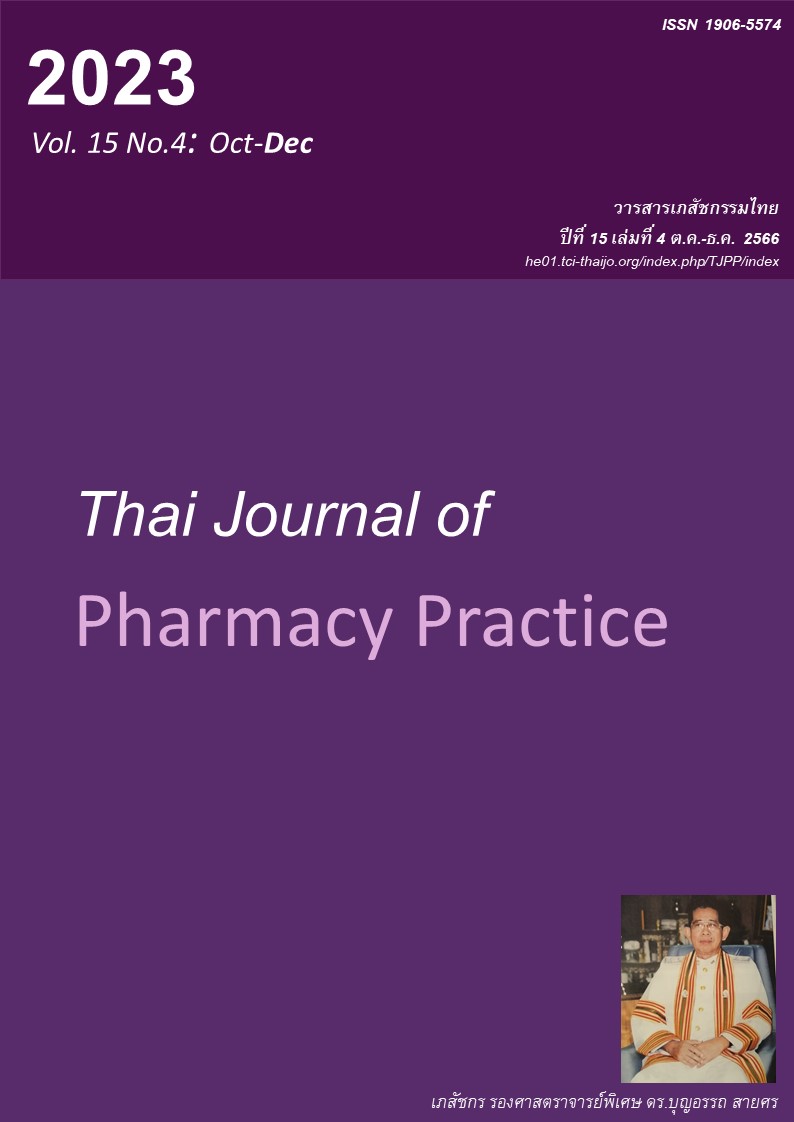ความเหมาะสมของขนาดยาเริ่มต้นในการสั่งใช้อีน๊อกซาพารินและการเกิดเลือดออก ที่รุนแรงในผู้ป่วยภาวะหัวใจขาดเลือดเฉียบพลันชนิด ST segment ไม่ยกขึ้น
Main Article Content
บทคัดย่อ
วัตถุประสงค์: เพื่อศึกษาความเหมาะสมของขนาดยาเริ่มต้นในการสั่งจ่ายยาอีน๊อกซาพารินและการเกิดเลือดออกที่รุนแรงในผู้ป่วยภาวะหัวใจขาดเลือดเฉียบพลันชนิด ST segment ไม่ยกขึ้น หรือ non ST-segment elevation acute coronary syndrome (NSTEACS) วิธีการ: เป็นการศึกษาแบบเก็บข้อมูลย้อนหลังในผู้ป่วยที่ได้รับยาอีน๊อกซาพารินในการรักษา NSTEACS ระหว่างวันที่ 1 มกราคม พ.ศ. 2557 – 30 มิถุนายน พ.ศ. 2560 ในโรงพยาบาลมหาราชนครเชียงใหม่ โดยสำรวจความเหมาะสมของขนาดยาอีน๊อกซาพารินเริ่มต้นที่ผู้ป่วยได้รับซึ่งควรมีความแตกต่างจากขนาดยาแนะนำไม่เกิน 10 มก./วัน หรือไม่เกินร้อยละ 10 การศึกษาติดตามการเกิดภาวะเลือดออกที่รุนแรงตาม Bleeding Academic Research Consortium (BARC) type 3a-c และ type 5 ภายในระยะ 30 วัน ผลการวิจัย: ผู้ป่วยจำนวน 255 รายได้รับการวินิจฉัยเป็น non ST-elevation myocardial infarction (NSTEMI) 200 ราย และ unstable angina 55 ราย ผู้ป่วยมีอายุเฉลี่ย 63.8 ± 12.2 ปี เป็นเพศชาย 151 ราย มีน้ำหนักตัวเฉลี่ย 58 ± 13.4 กิโลกรัม eGFR เฉลี่ย 69.97 ± 24.03 มล./นาที/1.73 ตร.ม. ค่าเฉลี่ยของขนาดยาอีน๊อกซาพารินต่อน้ำหนักตัวที่ได้รับ คือ 0.88 ± 0.17 มก./กก. ผู้ป่วยได้รับยาอีน๊อกซาพารินในขนาดเริ่มต้นเหมาะสมโดยมีความแตกต่างจากขนาดยาแนะนำไม่เกิน 10 มก./วัน จำนวน 96 ราย (ร้อยละ 36.1) หรือแตกต่างจากขนาดยาแนะนำไม่เกินร้อยละ 10 จำนวน 80 ราย (ร้อยละ 31.4) พบภาวะเลือดออกที่รุนแรงในผู้ป่วยจำนวน 11 ราย (ร้อยละ 4.3) การวิเคราะห์ถดถอยโลจิสติกพหุพบว่า อายุตั้งแต่ 75 ปีขึ้นไปเป็นปัจจัยเสี่ยงของการเกิดเลือดออกที่รุนแรง (aOR= 5.47, 95%CI: 1.41 - 21.16, P = 0.01) สรุป: ผู้ป่วย NSTEACS โดยส่วนใหญ่ได้รับยาอีน๊อกซาพารินในขนาดที่ไม่เหมาะสม การสั่งใช้ยาอีน๊อกซาพารินควรพิจารณาตามน้ำหนักจริง และควรเฝ้าระวังการเกิดเลือดออกที่รุนแรงในผู้ป่วยที่สูงอายุ
Article Details

อนุญาตภายใต้เงื่อนไข Creative Commons Attribution-NonCommercial-NoDerivatives 4.0 International License.
ผลการวิจัยและความคิดเห็นที่ปรากฏในบทความถือเป็นความคิดเห็นและอยู่ในความรับผิดชอบของผู้นิพนธ์ มิใช่ความเห็นหรือความรับผิดชอบของกองบรรณาธิการ หรือคณะเภสัชศาสตร์ มหาวิทยาลัยสงขลานครินทร์ ทั้งนี้ไม่รวมความผิดพลาดอันเกิดจากการพิมพ์ บทความที่ได้รับการเผยแพร่โดยวารสารเภสัชกรรมไทยถือเป็นสิทธิ์ของวารสารฯ
เอกสารอ้างอิง
The Heart Association of Thailand. Thai acute coronary syndromes guideline 2020. Bangkok: Nextstep d-sign; 2020.
Collet JP, Thiele H, Barbato E, Barthélémy O, Bauersachs J, Bhatt DL, et al. 2020 ESC guidelines for the management of acute coronary syndromes in patients presenting without persistent ST-segment elevation. Eur Heart J 2021; 42: 1289–367.
Jinatongthai P, Khaisombut N, Likittanasombat K, Chaiyakunapruk N, Watcharathanakij S, Nathisuwan S. Use of the CRUSADE bleeding risk score in the prediction of major bleeding for patients with acute coronary syndrome receiving enoxaparin in Thailand . Heart Lung Circ. 2014; 23: 1051–8.
Macie C, Forbes L, Foster GA, Douketis JD. Dosing practices and risk factors for bleeding in patients receiving enoxaparin for the treatment of an acute coronary syndrome. Chest. 2004; 125: 1616–21.
LaPointe NMA, Chen AY, Alexander KP, Roe MT, Pollack CV, Lytle BL, et al. Enoxaparin dosing and associated risk of in-hospital bleeding and death in patients with non ST-segment elevation acute coronary syndromes. Arch Intern Med. 2007; 167: 1539–44.
Spinler SA, Inverso SM, Cohen M, Goodman SG, Stringer KA, Antman EM, et al. Safety and efficacy of unfractionated heparin versus enoxaparin in patients who are obese and patients with severe renal impairment: analysis from the ESSENCE and TIMI 11B studies. Am Heart J. 2003; 146: 33–41.
Amsterdam EA, Wenger NK, Brindis RG, Casey DE, Ganiats TG, Holmes DR, et al. 2014 AHA/ACC guideline for the management of patients with non-ST-elevation acute coronary syndromes: a report of the American College of Cardiology/American Heart Association task force on practice guidelines. J Am Coll Cardiol 2014; 64: e139–228.
Kiatchoosakun S, Wongvipaporn C, Buakhamsri A, Sanguanwong S, Moleerergpoom W, Sarakarn P, et al. Predictors of in-hospital mortality in non-ST elevation acute coronary syndrome in Thai Acute Coronary Syndrome Registry (TACSR). J Med Assoc Thai. 2007; 90 Suppl 1: 41–50.
Cavender MA, Rao SV, Ohman EM. Major bleeding: management and risk reduction in acute coronary syndromes. Expert Opin Pharmacother. 2008; 9: 1869–83.
Mehran R, Rao SV, Bhatt DL, Gibson CM, Caixeta A, Eikelboom J, et al. Standardized bleeding definitions for cardiovascular clinical trials: a consensus report from the Bleeding Academic Research Consortium. Circulation 2011; 123: 2736–47.
Spinler SA, Dobesh P. Dose capping enoxaparin is unjustified and denies patients with acute coronary syndromes a potentially effective treatment. Chest 2005; 127: 2288–9.
Enoxaparin. In: Lexi-drugs online [database on the Internet]. Hudson (OH): Lexicomp, Inc.; 2022 [updated 11 Apr 2022; cited 14 Nov 2022]. Available from: http://online.lexi.com. Subscription required to view.
Enoxaparin. In: Clinical Pharmacology [database on the Internet]. Tampa (FL): Elsevier; 2022 [cited 2022 Nov 14]. Available from: www.clinicalpharmacology .com. Subscription required to view.
Wayne WD. Biostatistics: A foundation of analysis in the health sciences. 6th ed. Atlanta, GA: John Wiley & Sons; 1995; p. 180.
Xu Y, Gomes T, Wells PS, Pequeno P, Johnson A, Sholzberg M. Evaluation of definitions for oral anticoagulant-associated major bleeding: A popula- tion-based cohort study. Thromb Res. 2022; 213: 57–64.
Chua D, Tataru A. Enoxaparin dosing for acute coronary syndromes in obese patients-should there be a maximum dose? J Cardio Cardiovasu Med 2016; 1: 1-4.
Spinler SA, Ou FS, Roe MT, Gibler WB, Ohman EM, Pollack CV, et al. Weight-based dosing of enoxaparin in obese patients with non-ST-segment elevation acute coronary syndromes: results from the CRUSADE initiative. Pharmacotherapy. 2009; 29: 631–8.
Inker LA, Eneanya ND, Coresh J, Tighiouart H, Wang D, Sang Y, et al. New creatinine- and cystatin C-based equations to estimate GFR without race. N Engl J Med. 2021; 385: 1737–49.
Cockcroft DW, Gault MH. Prediction of creatinine clearance from serum creatinine. Nephron. 1976; 16: 31–41.
Henderson MC, White RH. Anticoagulation in the elderly. Curr Opin Pulm Med. 2001; 5: 365–70.
Cinch D, Banerjee AK, Ostick G. Absence of abdominal pain in elderly patients with peptic ulcer. Age Ageing. 1984; 13: 120–3.
Cadroy Y, Pourrat J, Baladre MF, Saivin S, Houin G, Montastruc JL, et al. Delayed elimination of enoxaparin in patients with chronic renal insufficiency. Thromb Res. 1991; 63: 385–90.
Damluji AA, Forman DE, Wang TY, Chikwe J, Kunadian V, Rich MW, et al. Management of acute coronary syndrome in the older adult population: a scientific statement from the American Heart Association. Circulation. 2023; 147: e32-62.
Ibbotson T, Goa KL. Enoxaparin: an update of its clinical use in the management of acute coronary syndromes. Drugs. 2002; 62: 1407–30.


